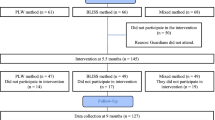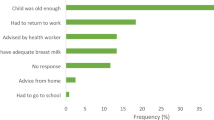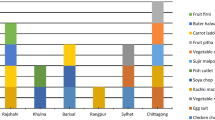Abstract
Background/Objectives:
The World Health Organization (WHO) recommends nutritionally adequate complementary feeding (CF) through the introduction of indigenous foodstuffs and local foods while breastfeeding for at least 2 years. To determine the adequacy of the contribution of CF to the diets of Guatemalan infants at the 7th–12th month of life receiving high-intensity continued breastfeeding.
Subjects/Methods:
Critical nutrient densities for CF were modelled using age- and sex-specific energy and protein requirements assuming children to be at the 50th weight percentile of local peers and 15th weight percentiles of the 2006 WHO standards. Nutrient requirements for the total diet were determined using the recommended nutrient intakes. Breast milk was assumed to provide 75% of total energy at the 7th–9th month and 50% at the 10th–12th month. Gaps between computed critical nutrient densities and the CF consumption of 128 Guatemalan infants based on data collected by means of three nonconsecutive 24-h quantitative intake recalls were examined. Locally consumed foods with nutrient densities above the modelled critical densities were identified.
Results:
Observed non-breast milk complementation would result in total diets providing inadequate nutrient density for vitamin A, niacin and vitamin C in some age groups. Major gaps for calcium, iron and zinc were ubiquitous across all groups. Few foods commonly consumed among Guatemalan infants had adequate densities of ‘problem nutrients’.
Conclusions:
The critical nutrient density concept is useful to evaluate the nutrient adequacy of the infant’s diet. Fortified foods are essential sources of the main ‘problem nutrients’, namely calcium, iron and zinc, given that natural sources are scarce.
This is a preview of subscription content, access via your institution
Access options
Subscribe to this journal
Receive 12 print issues and online access
$259.00 per year
only $21.58 per issue
Buy this article
- Purchase on Springer Link
- Instant access to full article PDF
Prices may be subject to local taxes which are calculated during checkout
Similar content being viewed by others
References
World Health Organization. The optimal duration of exclusive breastfeeding: Report of an expert consultation. WHO: Geneva, Switzerland, 2001.
Fewtrell MS, Morgan JB, Duggan C, Gunnlaugsson G, Hibberd PL, Lucas A et al. Optimal duration of exclusive breastfeeding: what is the evidence to support current recommendations? Am J Clin Nutr 2007; 85: 635S–638S.
World Health Organization. Global strategy for infant and young child feeding. World Health Organization: Geneva, 2003.
Dewey KG . Infant feeding and growth. Adv Exp Med Biol 2009; 639: 57–66.
Nommsen-Rivers LA, Dewey KG . Growth of breastfed infants. Breastfeed Med 2009; 4 (Suppl 1), S45–S49.
World Alliance for Breastfeeding Action Protecting, Promoting and Supporting Continued Breastfeeding from 6–24+Months: Issues, Politics, Policies & Action, 2008.
Brown KH, Dewey KG, Allen LH . Complementary feeding of young children in developing countries: a review of current scientific knowledge. WHO/NUT/98.1. World Health Organization: Geneva, Switzerland, 1998.
International Baby Food Action Network What is complementary feeding? A philosophical reflection to help a policy process. A discussion paper developed for the International Baby Food Action Network (IBFAN) by Gabrielle Palmer, 2009.
Vossenaar M, Solomons NW . The concept of ‘critical nutrient density’ in complementary feeding: the demands of the ‘family foods’ for the nutrient adequacy of young Guatemalan children with continued breastfeeding. Am J Clin Nutr 2012; 95: 859–866.
Santika O, Fahmida U, Ferguson EL . Development of food-based complementary feeding recommendations for 9- to 11-month-old peri-urban Indonesian infants using linear programming. J Nutr 2009; 139: 135–141.
Ferguson EL, Briend A, Darmon N . Can optimal combinations of local foods achieve the nutrient density of the F100 catch-up diet for severe malnutrition? J Pediatr Gastroenterol Nutr 2008; 46: 447–452.
Briend A, Darmon N, Ferguson E, Erhardt JG . Linear programming: a mathematical tool for analyzing and optimizing children's diets during the complementary feeding period. J Pediatr Gastroenterol Nutr 2003; 36: 12–22.
Campos R, Hernández L, Soto-Mendez MJ, Vossenaar M, Solomons NW . Contribution of complementary food nutrients to estimated total nutrient intakes for rural Guatemalan infants in the second semester of life. Asia Pac J Clin Nutr 2010; 19: 481–490.
Hernández L, Campos R, Enneman A, Soto-Mendez MJ, Vossenaar M, Solomons NW . Contribution of complementary food nutrients to estimated total nutrient intakes for urban Guatemalan infants in the second semester of life. Asia Pac J Clin Nutr 2011; 20: 572–583.
World Health Organization Food and Agriculture Organization of the United Nations, University UN. Human energy requirements. Report of a Joint FAO/WHO/UNU Expert Consultation, 17–24 October 2001, Rome, Italy 2004.
Mayorga RA Aplicación de los nuevos estándares OMS 2006 en el diagnostico de bajo peso nutricional a través del indicador peso/edad, en infantes de seis a doce meses de edad en área rural y urbana de Guatemala (Application of the new WHO 2006 growth standards to identify malnourished infants based on the weight-for-age indicator in 6 to 12 mo old infants in rural and urban areas of Guatemala). University of San Carlos, Guatemala: Guatemala City, 2008.
WHO Multicenter Growth Reference Study Group. WHO Child Growth Standards: Methods and Development. World Health Organization: Geneva, Switzerland, 2006.
World Health Organization. Protein and amino acid requirements in human nutrition. Report of a joint FAO/WHO/UNU Expert Consultation (WHO Technical Report Series; no. 935). World Health Organization: Geneva, Switzerland, 2007.
World Health Organization. Food and Agriculture Organization of the United Nations. Vitamin and mineral requirements in human nutrition, Second edition. World Health Organization, Food and Agriculture Organization: Geneva, Switzerland, 2004.
U.S Department of Agriculture National Nutrient Database for Standard Reference. No. 22. 2009 [updated 2009; cited May 2010]. Available from http://www.ars.usda.gov/Services/docs.htm?docid=18879.
Enneman A, Hernández L, Campos R, Vossenaar M, Solomons NW . Dietary characteristics of complementary foods offered to Guatemalan infants vary between urban and rural settings. Nutr Res 2009; 29: 470–479.
Dewey KG, Brown KH . Update on technical issues concerning complementary feeding of young children in developing countries and implications for intervention programs. Food Nutr Bull 2003; 24: 5–28.
Enneman A, Campos R, Hernández L, Palma AV, Vossenaar M, Solomons NW . Contribution of complementary foods to the total daily water needs of urban Guatemalan infants. J Hum Nutr Diet 2010; 23: 520–528.
Dewey KG, Romero-Abal ME, Quan de Serrano J, Bulux J, Peerson JM, Engle P et al. Effects of discontinuing coffee intake on growth and morbidity of anemic Guatemalan toddlers: a randomized intervention study. J Nutr 1997; 127: 306–313.
Acknowledgements
This project received financial support from the Hildegard-Grunow Foundation for Nutrition Research (HGF), Germany.
Author information
Authors and Affiliations
Corresponding author
Ethics declarations
Competing interests
The authors declare no conflict of interest.
Rights and permissions
About this article
Cite this article
Vossenaar, M., Hernández, L., Campos, R. et al. Several ‘problem nutrients’ are identified in complementary feeding of Guatemalan infants with continued breastfeeding using the concept of ‘critical nutrient density’. Eur J Clin Nutr 67, 108–114 (2013). https://doi.org/10.1038/ejcn.2012.170
Received:
Revised:
Accepted:
Published:
Issue Date:
DOI: https://doi.org/10.1038/ejcn.2012.170



